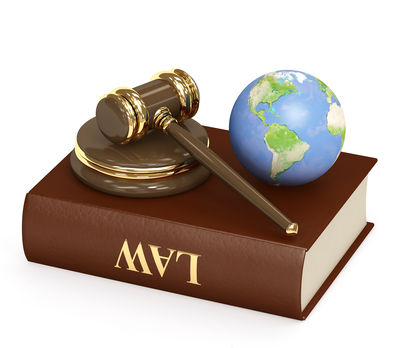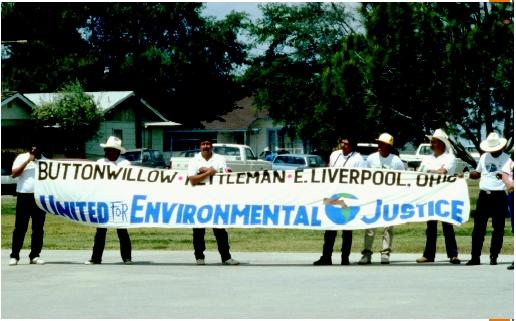Environmental Justice

Environmental justice is broader in scope than environmental equity (equal treatment and protection under statutes, regulations, and practices), emphasizing the right to a safe and healthy environment for all people, and incorporating physical, social, political, and economic under the heading of environments. It is also a less incendiary term than environmental racism, which can be intentional or unintentional, and suggests discrimination in

Issues central to environmental justice revolve around the siting of municipal landfills, hazardous waste facilities, and nuclear-waste dumps; manufacture and sale of hazardous products; the international distribution of toxic wastes; emissions from chemical plants; lead paint exposure and other public health risks in urban residences; and occupational hazards including pesticides on agricultural lands. In addition, environmental racism not only applies to African-Americans, but also Native Americans, Asian-Americans, Hispanic-Americans, and other people of color throughout the world.
The emergence of the environmental justice movement in the 1980s stimulated debate on the extent to which race, class, and political power have been or should become central concerns of modern environmentalism and environmental management. Movement leaders charged that mainstream environmental organizations and environmental policy demonstrated greater concern for preserving wilderness and animal habitats than protecting the homes and workplaces of humans. Some advocates disassociate themselves from environmentalism altogether, identifying instead with a heritage of broader social justice imbedded in the civil rights activities of the 1950s and 1960s.
Some observers date the environmental justice movement to Bean v. Southwestern Waste Management Corp. (1979), in which African-American residents of the Northwood Manor subdivision in Houston, Texas, filed the first class action lawsuit (later unsuccessful) challenging the siting of a waste facility in their neighborhood as a violation of civil rights. The key event was a related protest in Warren County, North Carolina, in 1982. Rev. Benjamin F. Chavis Jr., executive director of the United Church of Christ's Commission for Racial Justice (CRJ), is credited with coining the term "environmental racism." He became interested in the connection between race and pollution when residents of predominantly African-American Warren County asked the CRJ for help in preventing the siting of a PCB dump in their community. The protest did not reverse plans for the disposal site, and it resulted in the arrest of more than 500 people, including Chavis. However, this event galvanized environmental justice advocates, and a full-scale movement formed as a result.
In October 1991 a multiracial group of more than 600 advocates met in Washington, D.C., for the first National People of Color Environmental Leadership Summit. In their Principles of Environmental Justice, conference participants asserted the hope "to begin to build a national and international movement of all peoples of color to fight the destruction and taking of our lands and communities. . . ." Dramatic charges of environmental racism, and the call for a new program of environmental justice took center stage. Among the goals stated in the principles was "to secure our political, economic and cultural liberation that has been denied for over 500 years of colonization and oppression, resulting in the poisoning of our communities and land and the genocide of our peoples."
The movement found strength at the grassroots level, especially among low-income people of color who faced serious environmental threats from hazardous wastes. Its leaders are academics like sociologist Robert Bullard and social activists like Chavis. For those articulating the goals of environmental justice, grassroots resistance to environmental threats is seen as a reaction to more fundamental injustices brought on by economic and social disparities. In some instances, the critique extends to questioning the capitalist system and bias in favor of Eurocentric—or Western white—social viewpoints. On one level, efforts to characterize the environmental justice movement as having its historic roots in civil rights activism, but not in the environmental movement, grew out of a desire to maintain a unique identity for the sake of its political goals.
The Warren County incident and other cases convinced Chavis and his colleagues that a national study correlating race and toxic waste sites was in order. In 1987 the CRJ published Toxic Wastes and Race in the United States (1987), the first comprehensive national study of the demographic patterns associated with the location of hazardous waste sites. It stressed that the racial composition of a community was the single variable best able to predict the siting of hazardous waste facilities in a community, and added that it was "virtually impossible" that these facilities were distributed by chance. The report, especially its strong inference of deliberate targeting, strengthened the position of environmental justice advocates, but it also set off a controversy over the importance of race as the central variable in that targeting. Contradictory opinions stressed the importance of economic class instead of or in addition to race, and some questioned the extent to which the placement of toxic facilities was clearly intentional.
For environmental justice advocates, the culprit in deliberate targeting was not simply private companies, but government inaction amplified by political impotence linked to race and class. The federal executive branch, however, became more visible in the 1990s in helping to elevate environmental justice concerns to national attention. In 1992 the U.S. Environmental Protection Agency (EPA) established the Office of Environmental Justice. Its purpose was to ensure that all citizens, especially those of color or low income, received protection under existing environmental laws. Other initiatives within the EPA soon followed, and the Department of Energy (DOE) also drafted environmental justice guidelines for consideration in compliance issues. Similar action to craft policy on the basis of environmental justice concerns was carried out in states like New York and Texas.
A 1992 EPA report supported some of the claims regarding the exposure of racial minorities to high levels of pollution, but it linked together race and class in most cases. A study conducted by the National Law Journal that same year questioned the EPA's environmental equity record, pointing out that in the administration of the Superfund program, disparities existed in dealing with hazardous waste cleanups in minority communities as compared with white neighborhoods.
Although President Bill Clinton signed an executive order "Federal Actions to Address Environmental Justice in Minority Populations and Low-Income Populations" in 1994, frustrations among environmental justice advocates deepened when an official Environmental Justice Act failed to pass Congress. Furthermore, no successful lawsuits have been litigated to date. Not surprisingly, enthusiasm for government action on environmental justice issues has waned among activists, and the movement's programmatic activities have instead primarily focused on public information campaigns, media outreach, brownfield economic redevelopment pilot projects, and internal organizational changes. Debate also centers on what determines 'disproportionate burden' for the poor and people of color as stated in the EPA definition of environmental justice. Aggressive litigation against polluters or congressional support for more stringent protection have not been forthcoming.
There is little doubt that the environmental justice movement has gained the attention of federal and state governments, mainstream environmentalists, scholars, and others. Some traditional environmental groups and environmental justice activists have made attempts to form alliances or sponsor joint ventures such as an environmental consortium for minority outreach in Washington, D.C. The successful campaigns for social justice have publicized the movement's cause and continued its mission. It has drawn on traditional grassroots support to reinforce its claim of being a broad-based movement and it has questioned the will and objectives of modern environmental groups to offer a definition of environmentalism that is sufficiently broad to encompass the interests of minority groups, the poor, the disadvantaged, and the politically impotent.
SEE ALSO A CTIVISM ; E ARTH S UMMIT ; G AULEY B RIDGE , W EST V IRGINIA ; P OVERTY ; W ARREN C OUNTY , N ORTH C AROLINA ; Y UCCA M OUNTAIN .
Bibliography
Bullard, Robert D. (1994). Unequal Protection: Environmental Justice and Communities of Color. San Francisco, CA: Sierra Club Books.
Foreman, Christopher H., Jr. (1998). The Promise and Peril of Environmental Justice. Washington, DC: Brookings Institution.
Lester, James P.; Allen, David W.; and Hill, Kelly M. (2001). Environmental Injustice in the United States: Myths and Realities. Boulder, CO: Westview Press.
Internet Resources
Environmental Justice Resource Center Web site. Available from http://www.ejrc.cau.edu .
U.S. Environmental Protection Agency Web site. Available from http://www.epa.gov/swerosps .
Martin V. Melosi